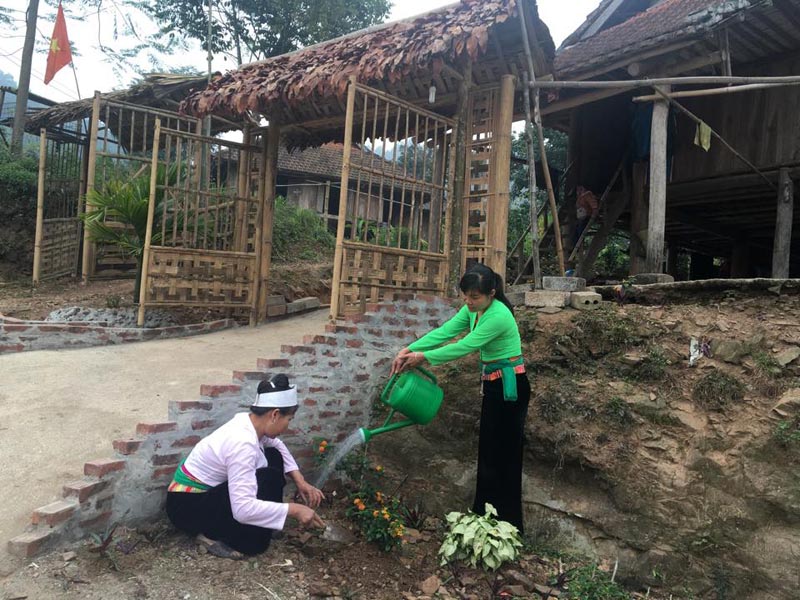
(HBO) - Ai Village, Phong Phu Commune (Tan Lac) is known as the ancient village of Muong Bi Area, one of the 20 traditional villages of typical ethnic minorities invested by the State in conversation and embellishment.

The gate house is deeply Muong village
architecture, the campus full of flowers is a highlighted attraction to
visitors to Muong Ai village, Phong Phu commune (Tan Lac).
Exploring the ancient
Muong village of Ai villgage is quite interesting because hardly no places like
this place still hold nearly 100% of traditional style stilt houses. The road into
the village is through the bridge across the bridge to the Ai stream of clear
blue water, calm and peaceful nature. 100% of the households living there are
Muong ethnic people with long cultural traditions, many features in the dining
and speaking customs, living habits are still preserved. Visitors can also
experience the unique characteristics of the living habits, cultural
characteristics of the Muong ethnic people with water rice cultivation, cotton
growing, weaving, hunting ... Many Muong families also preserve gongs, traditional
folk songs of THUONG RANG, Bo MENG.
However, besides the
good first impressions about Muong ancient village, tourists also have a lot of
anxiety when traveling in Ai village. Athanael, a visitor from Marseille
(France) said that: In addition to keeping and preserving traditional cultural
values, visitors have some certain requirements for environmental landscapes
and supporting factors. When I visited Muong Ai village before, it still missed
those important factors. In particular, rural sanitation is a matter of
concern. Besides two standardized homestay accommodations, visitors couldn’t find
another place to eat and stay which met all of their accommodation requirements.
This also explained the reason why Muong Ai village before was very rare for
guests to stay and take a rest. Most of the visitors found it inconvenient and
unsatisfactory with the lack of accommodation, especially while staying there.
In order to make a change,
indiscriminately waste dispose has been improved much. Most of the households
have moved the cattle cages far from their habitats. Some households paid
attention to invest and renovate hygienic toilets. After a short time, from October
2017 to March 2018, with the mobilization of community activities, the environment
and landscapes in Muong Ai village have changed positively. The houses of the
households are cleaned up to be always clean and tidy. Every house has gates,
fences, especially all the gates are made from imperata cylindrica, bamboo, and
leaves available towards the prototype of the house gate of the Muong people
from the ancient times. Another impression is that along the main road of the village
into each house is covered with a lot of flowers just after a few months of
effort. According to Mrs. Dinh Thi Dun, the head of the Women's Union of Ai
village, this is the idea of the women in the village to create the alleys
and roads more beautiful, colorful and fresher.
Ms. Chu Thi Mai Lan,
a visitor from Hanoi Capital remarked: "I am impressed with what I have
experienced in Muong Ai village on my recent visit. I was more attracted by the
beautiful landscape created by the families together. It is extremely
interesting and pleasant to walk around the village, each house has a bamboo
gate, flower campus, bonsai, the road is stretched with grass flowers.
A diverse chain of eco-tourism and resort destinations concentrated in Hoa Binh city and the districts of Tan Lac, Da Bac, and Luong Son… Along with the launch of several key high-quality resort tourism projects, these developments have reshaped the landscape and enhanced the appeal of Hoa Binh as a travel destination.
Boasting diverse terrain, a mild climate, and rich natural resources, Cao Phong district is increasingly asserting its place on Vietnam’s tourism map, attracting both domestic and foreign visitors. The district is renowned for its stunning landscapes, majestic mountains, a crystal-clear hydropower lake, and the unique cultural identity of local ethnic groups.
With its pristine landscapes, unique cultural heritage of Muong ethnic minority, and an expanding range of visitor experiences, Tan Lac district of Hoa Binh has fast become a captivating destination for both domestic and international tourists.
Until now, Sung village in Cao Son commune, Da Bac district remains the only Dao ethnic community in Hoa Binh province to develop a community-based tourism model. Beyond its untouched natural landscapes, cultural identity serves as the cornerstone attraction for visitors.
Alongside the diverse cultural identities of the Kinh, Muong, Tay, Thai, Dao, and Mong ethnic people, Hoa Binh province is also renowned as the "capital" of the northwestern Vietnamese cuisine, offering unique and distinctive dishes. At festivals, during Lunar New Year (Tet), or on significant family or community occasions, special dishes are prepared, leaving a lasting impression on visitors.
A Phong Linh (Yellow Tabebuia) flower garden in Thang village, Thach Yen commune, Cao Phong district is currently in full bloom, drawing a large number of visitors.



